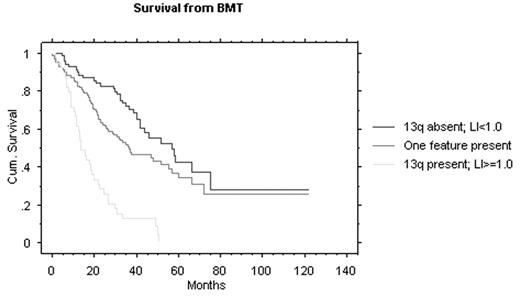Abstract
INTRODUCTION
The bone marrow plasma cell labeling index (PCLI) and the beta 2 microglobulin (β2M) when combined provide a powerful staging system highly predictive of outcomes in myeloma patients (
PATIENTS AND METHODS
238 patients undergoing high dose therapy between January 1990 and September 2001 were studied. The minimum follow-up of patients was 34 months. The median age of the cohort 56 years. Interphase fluorescence in situ hybridization with Probes LSI13/D13S319 was performed with simultaneous immunofluorescent detection of bone marrow plasma cells by the presence of cytoplasmic immunoglobulin. PCLI was done by a slide-based immunofluorescence method with antibodies to bromodeoxyuridine.
RESULTS
Of the 238 patients studied 215 had a successful FISH analysis and 212 of these had a bone marrow labeling index. Deletion 13 was absent in 104 patients (48%) and present in 111 patients. The overall survival and time to progression for patients lacking and having deletion 13 was 47.8 vs 26.4 (OS) and 19.0 vs 11.7 (TTP)months respectively. A Cox model was constructed with the PCLI, the presence or absence of deletion 13 and serum β2M. Although all three variables were independently predictive of survival and time to progression, the β2M was the weakest of these three variables. The hazard function for survival for PCLI, deletion 13 and β2M was 1.4, 1.6 and 1.1 respectively. A staging system was constructed assigning 1 point for the presence of deletion 13 or a PCLI ≥ 1%. Patients fell into 3 categories of 0 points (N=69), 1 point (N=104) and 2 points (N=39). The overall survival for the three groups respectively were 56.5, 36.6 and 13.7 months (figure). The time to progression for the three groups were 22.3, 15.4 and 8 months (P<0.001). When analysis was limited to those patients transplanted within 12 months of diagnosis the results remained significant (P<0.003) with median survivals of stage 0, 1 and 2 of 72.5, 59.1 and 15.4 months respectively. TTP for stage 0, 1 & 2 in this same cohort of patients transplanted < 12 mos after diagnosis is 30.6, 21.5 & 8.2 months respectively.
CONCLUSION
Deletion 13 by FISH is an independent predictor of survival and time to progression providing information independent of the β2M and the PCLI. Combining the PCLI with FISH del 13 identifies patients who following transplant have a median time to progression of 8 months and a median OS of 13.7 months. This group may not benefit from autologous transplant and are candidates for novel therapeutic approaches.
Author notes
Corresponding author


